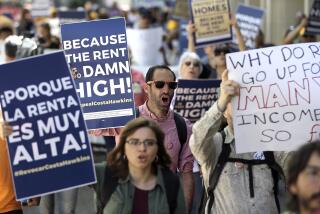How a new California law could kill a 30-year-old rule that slowed development in Los Angeles
Reporting from Sacramento — Thirty years ago, a neighborhood association in Westwood won a lawsuit against the city of Los Angeles over the approval of a 26-story office tower. The project, the group convinced an appellate court, shouldn’t have been permitted without an in-depth environmental review, even though the city said the building had met all its codes and requirements.
Ever since that landmark case, most every housing development in Los Angeles with 50 or more units has undergone a full environmental analysis — no matter whether the city’s zoning would otherwise allow the effort to go forward.
Now, that’s likely to change. The author of a new state law says it will eliminate Los Angeles’ rule.
“It would go away,” said state Sen. Scott Wiener (D-San Francisco).
Los Angeles’ policy, one of many implemented over decades that aimed to slow the city’s growth, is just one example of similar rules across the state that Wiener’s legislation aims to jettison. In cities such as Los Angeles that haven’t met housing growth targets set by the state, projects that comply with a host of zoning, affordability and labor standards won’t have to go through additional planning and environmental reviews that slow the pace and raise the costs of constructing housing.
Wiener’s legislation, Senate Bill 35, is among 15 bills Gov. Jerry Brown signed last week to address California’s housing problems and is the most prominent attempt in the legislative package to spur more development by clawing power away from cities and counties.
Many local restrictions, Wiener said, are a luxury the state cannot afford when California falls short of the tens of thousands of new homes needed annually to meet demand.
“We’re in a crisis,” he said.
In Los Angeles County, where median home prices have soared to a record $580,000, the new law isn’t likely to lead to a construction boom. But it does chip away at long-standing policies, such as the one inaugurated by the 1987 Westwood court decision, that make it more difficult for developers to build.
Los Angeles Mayor Eric Garcetti, who supported the legislation, said in an interview that SB 35 complements the city’s other efforts, such as relaxing development restrictions near transit lines, to ease production.
“A lot of people don’t want the brain damage or the headache of building affordable homes,” Garcetti said. “This makes it a much less painful process.”
The city’s current policy forces most projects 50 units or larger — regardless of whether they comply with zoning codes — to complete a full analysis under the California Environmental Quality Act, the state’s primary environmental law governing development. These analyses cost Los Angeles developers $200,000 to $300,000 each and add 18 months to the building process, and that’s before any potential challenge in court, said Jim Ries, a senior vice president at Craig Lawson & Co., a land-use consultant that advises on hundreds of city projects annually.
Wiener’s legislation aims to wipe that process away, but only for projects that meet a substantial number of conditions:
- They can’t be single-family homes and have to meet underlying zoning rules — so no 100-unit condominiums on land now planned for 50.
- They can’t be along the coast.
- They can’t replace rent-controlled housing or buildings that have been occupied by tenants in the previous 10 years.
- Developers have to pay construction workers union-level wages and abide by union-level hiring rules.
For Los Angeles, the guidelines are even stricter. Generally, Wiener’s legislation allows developers of market-rate homes to take advantage of the streamlined local review process. But because Los Angeles is exceeding its state housing growth targets for those earning higher-than-middle incomes, only projects that reserve at least half of their units for low-income residents will qualify. In Los Angeles, the current standard for low-income is a family of four earning no more than $72,100 a year.
The restrictions over how developers can use SB 35 means that it’s likely to have only a limited effect on housing production, said Joan Ling, a lecturer in urban planning at UCLA and former board member of the city’s redevelopment agency. No developer in Los Angeles has said it plans to use SB 35 once it takes effect Jan. 1, though Wiener said he’s been told a small project in his Bay Area district expects to take advantage.
“It remains to be seen how much it’s going to help,” Ling said.
Still, those who support Los Angeles’ current system believe SB 35 is misplaced. Laura Lake, who founded the Westwood neighborhood association that successfully sued the city in the 1980s and has initiated other high-profile environmental lawsuits, argues that legislators are scapegoating state environmental laws as the cause of the housing crisis. Instead, she said, the focus should be on trying to lower the costs of land, labor and materials.
Beyond that, Lake said, allowing community members to appeal projects through environmental reviews ensures more support from neighbors and fewer detrimental effects from development.
“Each time there is a constraint on the right to appeal,” Lake said, “to me it’s as chilling on the democratic process as voter suppression.”
ALSO
Southern California home prices jump again. Lots of residents worry about affordability
Updates on California politics











